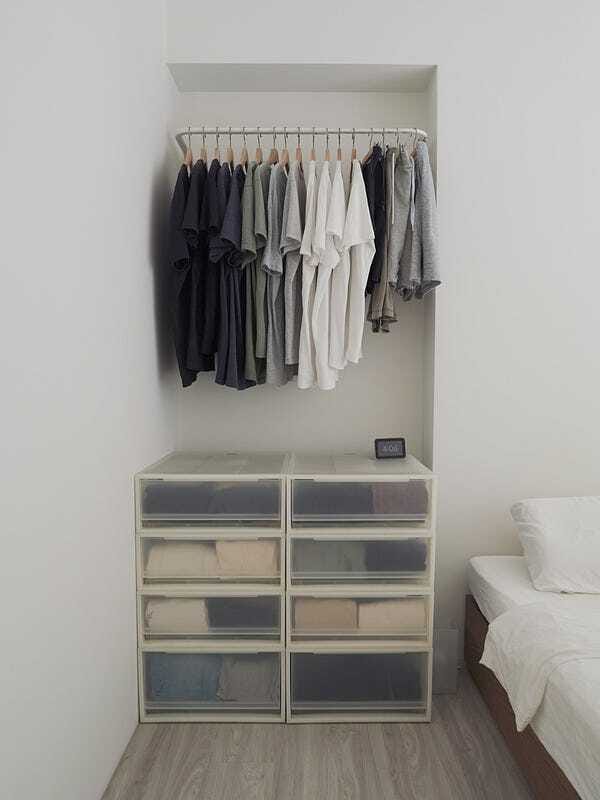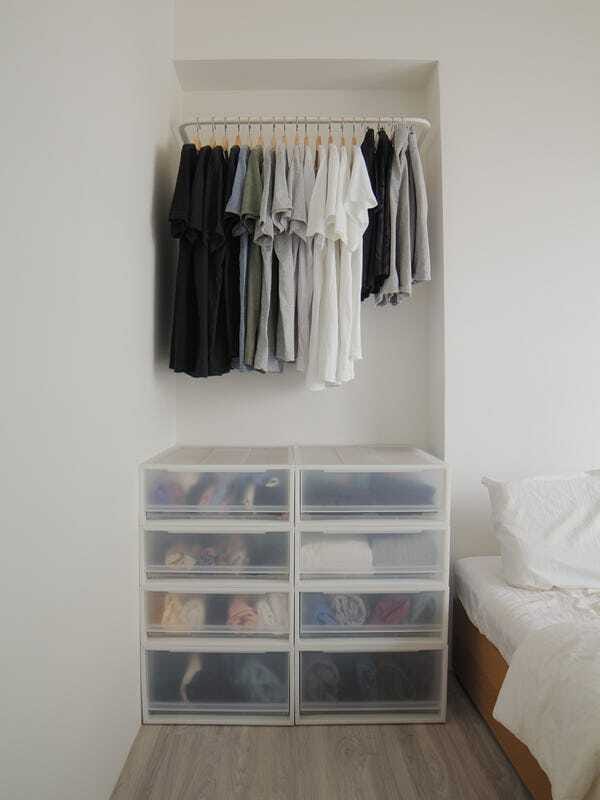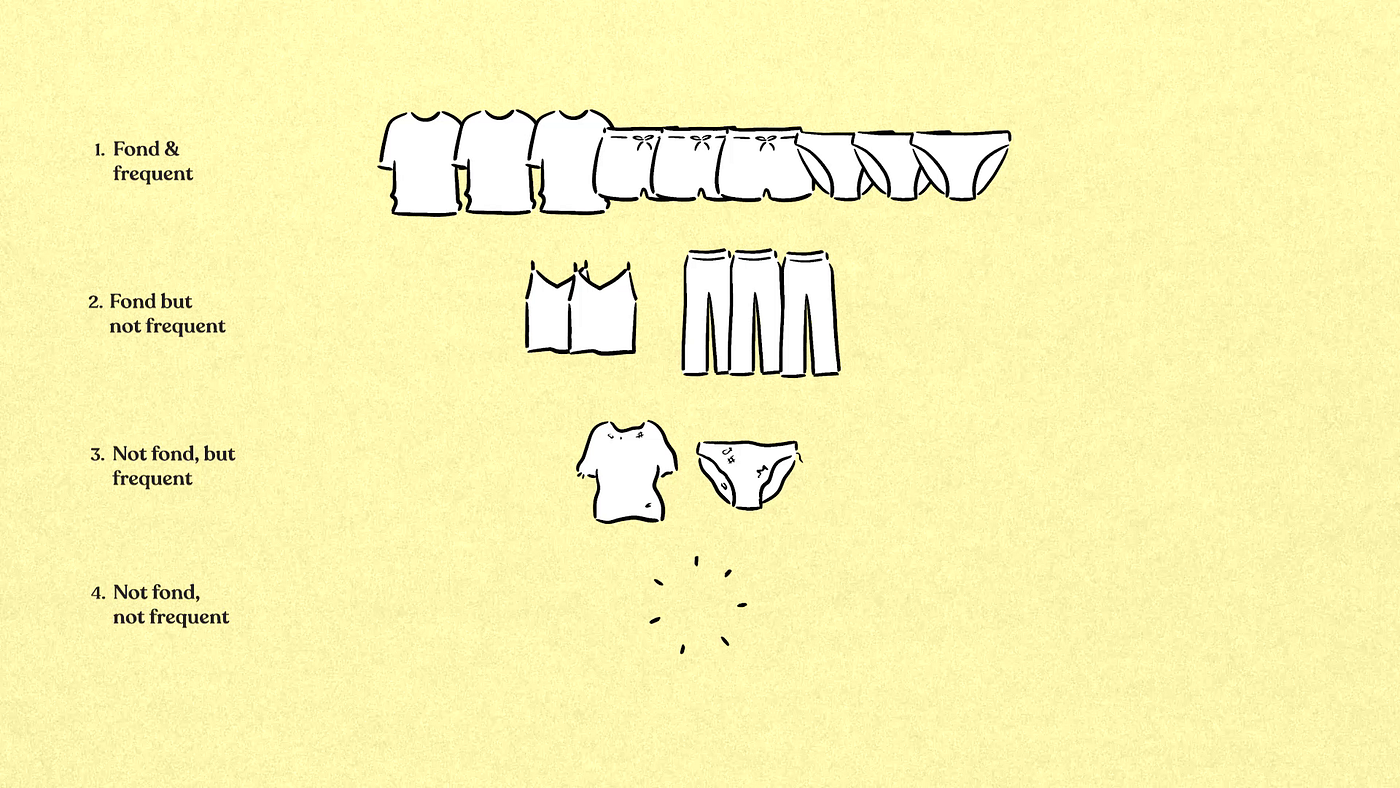
Our wardrobe today.

Our wardrobe 5 years ago.
Five years ago, we minimized our wardrobe for two to fit into a little nook in our new home’s bedroom. For the most part, we’ve managed to keep our wardrobe contained. The main reason for that would be our minimal amount of shopping, but we also conduct sporadic bursts of light decluttering from time to time.
Recently, our wardrobe has gotten slightly disorganized, and there was a hint of that feeling of “having nothing to wear”. So, it was time for a deep clean; let us share with you the thought process we used to declutter our wardrobe!
The Fondness/Frequency Matrix
The best way to describe our thought process of decluttering clothes would be what we coined the Fondness/Frequency Matrix™. For each piece of clothing, we’ll first consider its category (e.g. sportswear, loungewear, etc.) or the occasion (e.g. business meetings) we’re most likely to put it on.
After which, we have two criteria:
Fondness: If we had a choice, would we be happy to reach for that particular piece of clothing?
Frequency: How frequent is that occasion?
While the answers don’t have to be binary, essentially every piece of clothing will fall into one of four quadrants in a fondness/frequency matrix.

Tier 1: Clothes we’re fond of, and are required frequently
Tier 2: Clothes we’re fond of, but are not required frequently
Tier 3: Clothes we’re not fond of, but are required frequently
Tier 4: Clothes we’re not fond of, and are not required frequently
Tier 1 (fond, frequent) pieces are no-brainers. These are our favorite clothes we reach for the most often, so we would obviously keep them.
On the other hand, we found clothes in Tier 4 (not fond, not frequent) to be those we haven’t worn in years, and in all likelihood, never will again. If we had to dress up for rare occasions, we just don’t see why we would choose to put on clothes we’re not fond of if we had a choice. For almost all of these Tier 4 pieces, we find them to be easy decluttering decisions. They have no place in our wardrobe, so it’s time to say goodbye!
Tier 2 and 3 are not as simple, and it’s probably where most declutterers struggle.
The way we approach it is, that clothes in Tier 2 (fond, but not frequent) have an obvious place in our wardrobe as long as we’re positive there will be opportunities for us to put them on.
As for Tier 3 (not fond, but frequent), you can think of these as backup pieces. For example, if all of our favorite clothes are in the washer, we’d be glad to have these pieces to wear instead. It’s all personal preference, but we would rather put on tattered underwear than go commando! However, we have to be mindful not to hoard too many of these, as they are just meant to be backups.
Prefer to watch decluttering in action? Check out our video instead:
Practising material minimalism requires self-honesty.
Although we think the two fondness/frequency questions are laid out quite clearly, from time to time we’re still caught in a dilemma, confusing ourselves with our own answers. That’s because if there’s one obstacle most people face when decluttering, it’s the constant justification to keep something.
“But I look good in this color.”
“If I just had the right pair of pants to match this top, then I would be fond of it. I think.”
“What if I travel to a cold country, and I need all ten of these coats?” (Note: we live in a place where it’s summer all year round)
“Fondness” and “frequency” are going to look different from person to person. Here are some additional notes that will, hopefully, provide you with more clarity when decluttering.
Frequency
For our lifestyle, where we work from home on weekdays, and are homebodies on weekends, the clothes we require most frequently are loungewear, sportswear, and one-mile wear.
For someone who lives a more colorful life — office in a fancy part of town, loves to go drinking after work, and spends all weekend dressed up — they would have very different requirements for their wardrobe. So adjust the criteria of “frequency” to align with your lifestyle.
Fondness
There are many reasons to be fond of a piece of clothing. It’s comfortable, it’s flattering, there’s sentimental value, etc.
But for decluttering purposes, focus on the “choice” aspect of the question: If you had a CHOICE, would you reach for that piece of clothing?
Just because you love the design of a skirt, doesn’t mean it suits you well. If it doesn’t suit you, then it’s unlikely you’ll reach for it if you had a choice. Therefore, it doesn’t exactly fulfill the “fondness” criteria no matter how much you love the skirt’s design.
It’s important to be honest with ourselves when it comes to decluttering because no one else can make the decision for us!
The Ideal Wardrobe

The ideal “healthy” wardrobe.
Ideally, our wardrobe should look like an inverted triangle, filled with frequently worn clothes we’re fond of and less of clothes we’re not thrilled to reach for.
But when we have a wardrobe that’s out of balance — an upright triangle instead of an inverted triangle — that’s probably when we’ll find ourselves feeling like we have nothing to wear, despite having a wardrobe brimming with clothes.

“Unhealthy” wardrobe that makes us feel like we’ve got nothing to wear, despite having lots of clothes!
The “ideal” wardrobe is a personal thing, and it’s a constant work in progress.
Your wardrobe may not, and need not be as minimal as ours. We don’t experience winter here, so there’s no need for bulky winter wear. Neither of us are social butterflies with many events to attend, so there’s no need for us to look “fresh” all the time. For those reasons, we’re able to keep a minimal wardrobe that may be unrealistic for others.
Your wardrobe just has to be compatible with your lifestyle!
If it’s time for a round of wardrobe decluttering, try out this fondness/frequency matrix. We hope it’ll bring you more clarity :)
That’s all for today. Thanks for reading! If you wish, here are a few ways you can support our work.
👆 Follow us on YouTube and Instagram.
🛍 Browse our merch and digital products.
☕ Buy us coffee? That’ll be cool.
Lots of love,
Glo & HL
